
A bodysuit is a one-piece form-fitting or skin-tight garment that covers the torso and the crotch, and sometimes the legs, hands, and feet, and cannot be used as a swimsuit. The style of a basic bodysuit is similar to a one-piece swimsuit and a leotard, though the materials may vary. A bodysuit, unlike a swimsuit or leotard, has snaps, hooks or velcro at the crotch. Thong or T-front thong bodysuits usually have the crotch opening moved up to the front to underbelly area to increase the wearer's comfort. A bodysuit may have sleeves and varying shoulder strap and collar styles. Bodysuits can be made from a number of fabrics, including cotton, lace, nylon, etc. In general, textile bodysuits include expandable fiber such as spandex for a better fit to the shape of the body.

In humans, the crotch is the bottom of the pelvis and is often considered to include the groin and genitals.
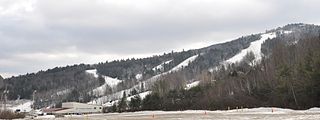
Crotched Mountain is a small mountain in western Hillsborough County, New Hampshire, in the United States. The 2,063-foot (629 m) summit of the mountain is in the town of Francestown, while the western slopes of the mountain rise in the town of Bennington, and a long southern ridge of the mountain is in Greenfield. The mountain was named for its appearance. Early settlers thought its V-shaped peaks resembled the fork or "crotch" of a tree.

George Robert Crotch was a British entomologist and an authority on Coleoptera (beetles), particularly the ladybird beetles. He was the grandson of the English composer and organist William Crotch.

The long-nosed snake is a species of nonvenomous snake in the family Colubridae. The species is endemic to North America. It has two recognized subspecies. The other species in the genus were previously considered subspecies.

Erotylidae, or the pleasing fungus beetles, is a family of beetles belonging to Cucujoidea containing over 100 genera. In the present circumscription, it contains 6 tribes and 10 subfamilies. In other words, the narrowly circumscribed Erotylidae correspond to the subfamily Erotylinae in the definition sensu lato. There are doubts on the monophyly of lower ranked taxa within Erotylidae, with further phylogenetic studies requiring better sampling and studies of unexplored character sets, for example the metendosternite and penile flagellum, which are generally lacking detailed morphological studies within the Coleoptera literature. The Eroytlina taxonomy is based on traits such as their different colors and not off morphological differences like mouthparts, thorax, and abdominal terminalia (Pecci-Maddalena).

The African dwarf kingfisher is a species of kingfisher in the Alcedininae subfamily.
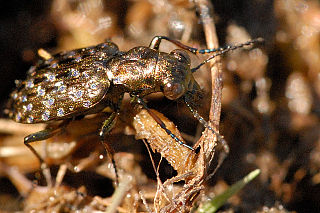
Elaphrus is a genus of ground beetle native to the Palearctic, the Nearctic, the Near East and Northern Africa. It contains the following species:

Elaphrus riparius is a species of ground beetle native to the Palearctic and the Near East. In Europe, it is found in Austria, Belarus, Belgium, Great Britain including Shetland, Orkney, Hebrides and Isle of Man, Bulgaria, Croatia, the Czech Republic, mainland Denmark, Estonia, Finland, mainland France, Germany, Hungary, Republic of Ireland, mainland Italy (doubtful), Kaliningrad, Latvia, Liechtenstein, Lithuania, Luxembourg, Northern Ireland, mainland Norway, Poland, Russia, Slovakia, Slovenia, mainland Spain, Sweden, Switzerland, the Netherlands, Ukraine and Yugoslavia.
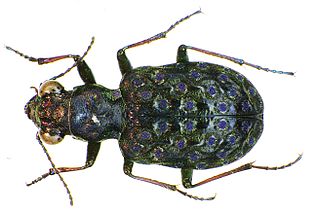
Elaphrus cupreus is a species of ground beetle native to the Palearctic. In Europe, it is found in Austria, Belarus, Belgium, Bosnia and Herzegovina, Great Britain including Shetland, Orkney, Hebrides and Isle of Man, the Czech Republic, mainland Denmark, Estonia, Finland, mainland France, Germany, Hungary, the Republic of Ireland, mainland Italy, Kaliningrad, Latvia, Liechtenstein, Lithuania, Luxembourg, Northern Ireland, mainland Norway, Poland, Russia, Slovakia, Slovenia, Sweden, Switzerland, the Netherlands, and Ukraine.

Elaphrus uliginosus is a species of ground beetle native to the Palearctic realm. It is widespread but rare in Europe, and is absent from much of Southern Europe. It is a wetland and coastal species.

Chauliognathus is a genus of soldier beetles in the family Cantharidae. Adults have almost rectangular bodies. Some are red and black, similar to the military uniforms that were common before the usage of camouflage, hence the name of soldier beetles. Others are orange and black. The elytra or first pair of wings are softer than the elytra of most beetles, that is why their other common name is leatherwings. The adults are frequently found on flowers, such as sunflowers, goldenrod, coneflowers, where they mate and feed on pollen and nectar. The larvae are more common in the ground or among debris, where they feed on eggs or larvae of other insects. The adults are most frequently found in summer and early fall. They are native to America and Australia.

Orchestes is a genus of beetles either classified in the subfamily Rhynchaeninae or in the tribe Rhamphini of the subfamily Curculioninae, of the family Curculionidae. It encompasses six species in North America, including Orchestes alni, and more in Eurasia. It was previously regarded as a synonym of Rhynchaenus, which is now used with a more restricted definition. The name Pedetes has been used as a manuscript name for this genus around 1799, but not published as a valid name.
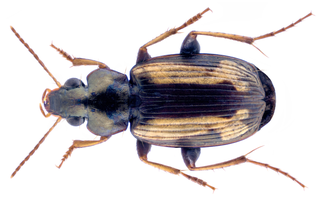
Tetragonoderus is a genus of beetles in the family Carabidae, containing the following species:

Magdalis is a genus of wedge-shaped bark weevils in the family Curculionidae. There are at least 20 described species in Magdalis.

Sibinia is a genus of leguminous seed weevils in the family Curculionidae. There are at least 20 described species in Sibinia.

Deloyala is a genus of tortoise beetles in the family Chrysomelidae. There are about 10 described species in Deloyala.
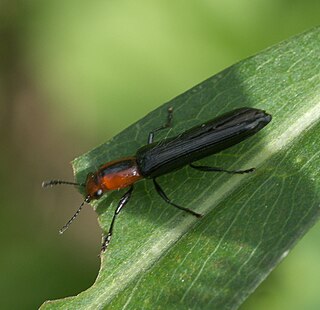
Acropteroxys is a genus of lizard beetles in the family Erotylidae. There are at least two described species in Acropteroxys.

Cypherotylus is a genus of pleasing fungus beetles in the family Erotylidae. There are over 30 described species in Cypherotylus. It frequently appears in the literature under the name "Gibbifer", but this name is permanently unavailable under ICZN Article 11.4, as are all of Voet's names.
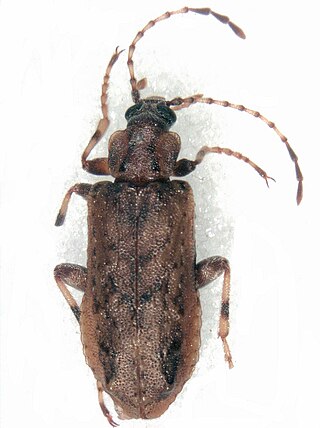
Promecheilidae is a family of beetles in the superfamily Tenebrionoidea. They were formerly included in a family called Perimylopidae. They are found in southern South America and associated archipelagos like South Georgia and the Falklands, New Zealand and Tasmania. Some species are associated tree ferns and moss-covered dead wood, and other forested habitats, while others are associated with peat bogs, grasslands and coastal habitats. They are probably phytophagus, feeding on lichen, moss, and other plant material.


















